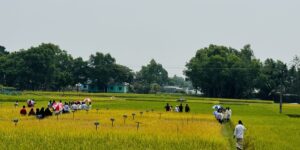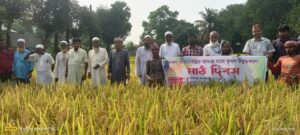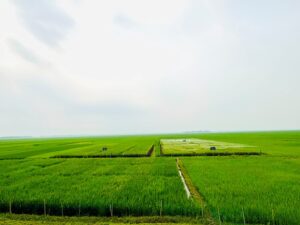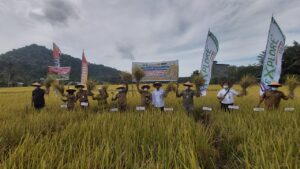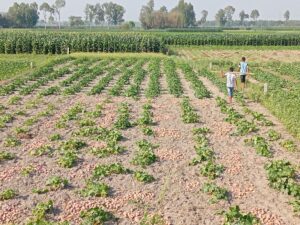
The leader, the machine, and the fighter are nicknames of three women farmers from Khanijipur, a village on the bank of the Prachi River, in the eastern Indian state of Odisha, located 40 kilometers from the state capital.
Married to farmers with less than half a hectare of land, they play a traditional role of women in their society: housewives. But now, they are also successful farmers, entrepreneurs, leaders, and motivators. They have a confidence that is rare.
Sukanti Swain, the leader

Sukanti lives in an extended family unit with her husband and three children, her mother-in-law, and her brother-in-law and his family. She is a high-school dropout.
Despite her lack of higher education, Sukanti manages a 2.3-hectare farm. (Only 0.3 ha of the land is owned by her family while the rest is under sharecropping–a farming system in which the landowner allows the tenant to use the land in return for a share of the crops produced on theland.) During the paddy-growing season, she spends most of her time in the field supervising all farm operations.
But, there is so much more to Sukanti than that. She also owns a small village grocery store and helps her husband with his pakhundibusiness (making of fence using bamboo sticks and coconut leaves, on which betel plants grow). She is the secretary of a women’s self-help group she founded a decade ago, and also serves as a community resource person for 10 other self-help groups in neighboring areas.
Her achievements are even more remarkable considering the difficulties she faced—a culture that is restrictive for women. She still vividly remembers trying to convince her own family and the villagers to form a self-help group 12 years ago. “In the past, women were not allowed to go outside the house to attend meetings,” Sukanti says. The villagers put pressure on her husband to dissuade her from forming a self-help group. They even questioned her character. “But, things are different now.”
Today, she even organizes gatherings of many government-sponsored programs involving male farmers of her community. Her demeanor and professionalism are unparalleled.
Sukanti admits she couldn’t have done all these things without the help of her family. Her husband gives her a hand in farm operations, her mother-in-law and children assist in managing her small grocery store, while her sister-in-law helps her in cooking meals and other household chores. Nevertheless, Sukanti, the leader, exhibited great courage and determination in changing the traditional image of an ideal Indian woman.
Sanjukta Naik, the machine

Unlike a large proportion of poor women in India who cannot read or write, Sanjukta is literate—in fact, she is a high-school graduate. She has two children in college, a son studying to be a police officer and a daughter who wants to be a teacher. Her youngest daughter dropped out of high school and helps her with the household work.
Unlike Sukanti, she has little support from her family as her husband works in a private company in a nearby district. Her husband sends about US$80 every month and comes home to visit a few times a year. However, not having her husband around has made her resourceful and independent.
Sanjukta grows paddy twice a year on 0.20 hectare of her own land and another 1.2 hectares through sharecropping. She also raises two cows and six goats. Apart from farming, she is involved in other money-making activities. She makes garlands, cuts betel nuts, bottles alata, which is a flower-based dye used to paint the feet of brides, and packs sindoor that Indian women apply on their forehead as dots or on hair parting. She makes nearly US$300 a year from these activities. Even with her busy schedule, she manages to serve as the president of the local self-help group.
All in all, her family’s annual income from selling paddy, milk, and goat and other nonfarming products; remittances from her husband; and an honorarium as an officer of their local group adds up to more than $3,400 per year. With this income, they can afford to pay for higher education—something many in her village could only dream of for their children. Sanjukta spends 15% of their total income on her children’s college education.
Her tireless efforts and seemingly inexhaustible energy have earned Sanjukta the nickname “the machine” as she works up to 20 hours a day, from 4 a.m. until midnight. For her, every minute of work is worth it because it means a better future for herself, her family, and the other women in her village who look up to her as their role model.
Rabi Pradhan, the fighter
Rabi’s story could have easily been a tragedy. After 25 years of marriage, her husband left her with their three children. Making matters worse, Rabi is illiterate—a handicap that can prevent women from improving their economic status. But, Rabi has one quality that sets her apart from other women in similar circumstances. She has an unbreakable spirit.
Since her husband abandoned them, she has rebuilt her life with the support of friends and family. Although landless, Rabi grows rice during the wet season and, come the dry season, she plants rice and mung bean on 0.80 hectare of land on a sharecropping basis. Without enough money for hired labor, Rabi does most of the field work by herself.
Recently, she borrowed money from the local women’s self-help group to start a betel leaf plantation on a small patch of land near her home. She also sells milk from her two cows. Altogether, she makes $1,800 annually selling paddy, betel leaves, and milk.
Rabi could have decided early on that her life situation was too hard without her husband, and that she and her children had no discernible future. But, the stakes were too high for Rabi, the fighter. Like Sukanti and Sanjukta, she turned to farming and other ancillary activities to improve the living standard of her family. With financial and emotional support from the women’s self-help group and its members, Rabi was able to rise above her limitations.
Contagious success
The success stories of Sukanti, Sanjukta, and Rabi have been contagious in the sense that other women in Khanijipur have been encouraged to take up farming and other activities to supplement their family income. It is a wave of change, created by women for women. Hopefully, this will sweep through other villages as well.
Written by Samarendu Mohanty, Bidhan Kumar Mohapatra, Swati Nayak, Arindam Samaddar, and Sampriti Baruah.


